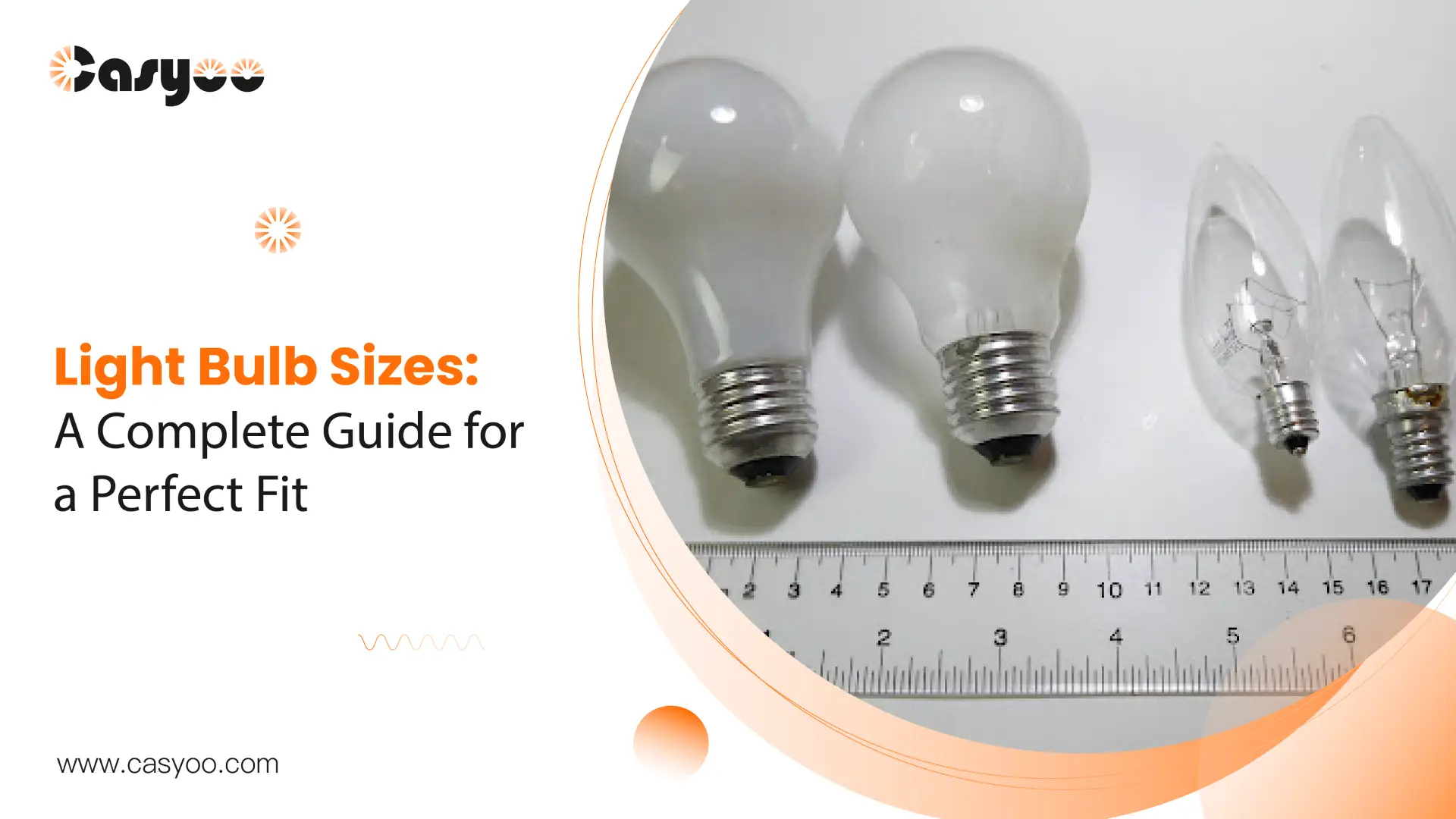Are you confused by the various model names when buying a light bulb? When the light bulbs in your lamps are broken, do you not know which light bulb sizes to choose to match the lamp holder? Read this article, and we will tell you the rules of light bulb size naming and which bases different sizes of the bulbs use. In addition, you will also know what to consider when choosing the most suitable light bulb. Next time you buy a light bulb, you will find it easier to know what the size of the light bulb is and how to choose light bulb size!
How are light bulb sizes named?
The official naming of the light bulb size consists of 6 parts, which is shown as (a)(b)(c)-(d)/(e)×(f), with each syllable representing a letter or number. But most light bulbs only have the (a) and (b) parts. For example, one common type of light bulb is called “A19.” Therefore, knowing these two parts is enough for most light bulb buyers.
(a) part
(a) consists of one or more capital letters, indicating the type of the light bulb. See the light bulb types chart below about the meaning of letters.
| Symbol | Meaning | Symbol | Meaning |
| A | Standard Household (Arbitrary) Incandescent Bulb | K | Narrow Reflector (Krypton Bulb) |
| B | Bulged or Bullet Tip Bulb | MB | Halogen Bulb |
| BT | Blown or Bulged Tubular Bulb | MR | Quartz Reflector Bulb (Multifaceted, often low-wattage) |
| BR | Short Reflector-Style Bulb (Bulged Reflector) | P | Pear-Shaped Bulb |
| C | Conical or Candle-Style Bulb | PAR | Parabolic Aluminized Reflector Bulb |
| CP | Crystalline Pear-Shaped Bulb | PS | Elongated Standard Incandescent Bulb |
| E | Ellipsoidal-Shaped Bulb | R | Reflector-Style Bulb |
| ER | Extended Reflector Bulb | S | Straight-Sided Bulb (Sign Bulb) |
| F | Flame-Style Candelabra Bulb | ST | Straight Tapered Bulb |
| G | Globe or Circular-Shaped Bulb | T | Tubular Bulb |
| HK | Hexagonal Candle Bulb |
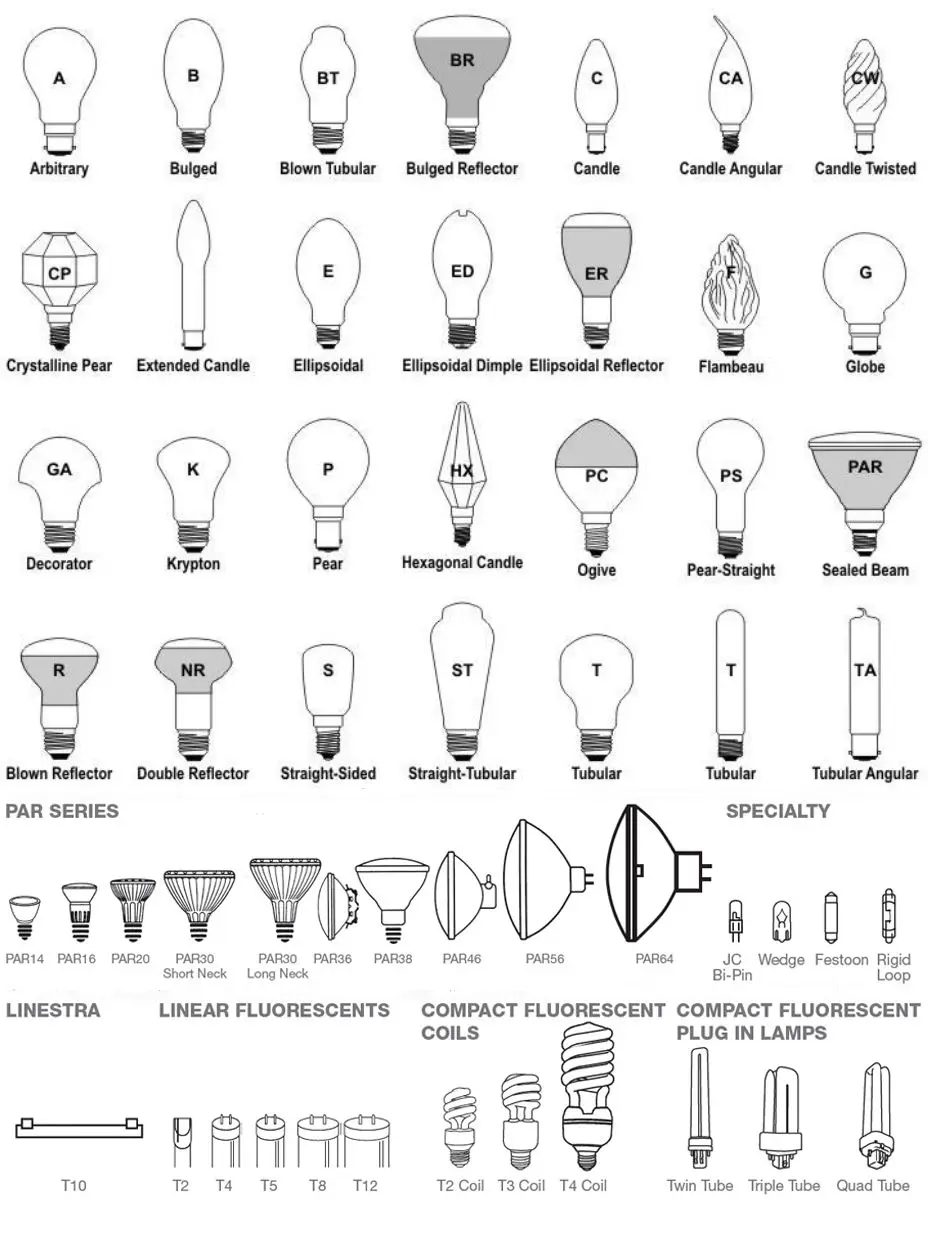 (b) part
(b) part
(b) is composed of numbers, which indicate the approximate value of the main dimensions of the bulb in mm. See the tables below about the meaning of numbers behind different letters.
| Letter in (a) part | Meaning of the number in (b) part |
| B, BT, BR, K, S, ST | The diameter of the shell |
| E | The crest diameter of the thread |
| F | The diameter of the contact or other similar dimensions |
| G | The distance between the centers of the two pins; for more than two pins, it refers to the diameter of the circumference of the center of each pin |
| P | The size of the part used to position the lamp horizontally |
| R | The maximum horizontal dimension of the necessary insulating part |
| T | The width between the outside of the two contacts |
For example:
- E26: Ellipsoidal-shaped bulbs, and the crew diameter is 26 mm
- G13: Double-pin bulbs, and the distance between the two pins is approximately 13 mm.
What are the light bulb base sizes?
Another way to name different types of the light bulb is to use the kind of lamp holder it matches. Common types of bulbs include:
- B14 and B22 bulbs use B14 and B22 bayonet (socket) lamp holders.
- E10, E14, E26, E27 and E40 bulbs use corresponding types of screw-type lamp holders, suitable for screw-type incandescent lamps, thin-tube fluorescent lamps, LED, and other light sources.
- Fa6 bulbs have one pin and can be inserted into a cylindrical base with a diameter of 6mm. Fa6 bulbs are suitable for instant-start fluorescent lamps.
- G5, G8, G13, GU5.3. GX5.3. GY6.35 and GZ4 are two-pin light bulbs, and the center distance between the two pins is 5mm, 8mm, 13mm, 5.3mm, 5.3mm, 6.35mm and 4mm. Among them, G5, G10, and G13 are suitable for double-ended straight tube fluorescent lamps, and GU5.3 and GX5.3 are suitable for single-ended halogen tungsten lamps. G10g bulbs have 4 pins, and the center distance between the pins is 10mm, which is suitable for round fluorescent lamps. The names and sizes of their corresponding bases are the same as those of the bulbs.
Besides these common types of light bulbs, the models of other light bulbs on the market are also very uniform. Below is a table about light bulbs and the type of base they use.
| Light bulb type | Base type |
| A-shape | E26/E27 |
| B-shape | E14 |
| E26/E27 | |
| MR16 | GU5.3 |
| PAR20, PAR30, PAR38 | E26/E27 |
| T8 tube | G13 |
| 2G11 | 2G11 |
Common sizes of light bulbs and their applications
MR16
MR16 refers to a lamp with a multifaceted reflector and the maximum outer diameter is 2 inches. Multifaceted (Mirror) Reflector, or MR for short, is a reflector made up of several reflective surfaces. The number after MR indicates the maximum size of the bulb. According to the convention, this number means how many 1/8 inches. “16” means 16 1/8 inches, that is, 2 inches. Most low-voltage (12V, 24V, 36V, etc.) lights and common spotlights use MR16 bulbs.
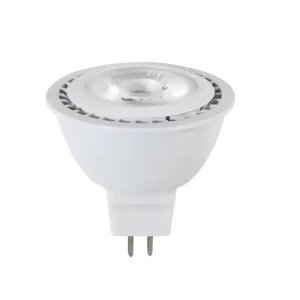
GU10
G means a plug-in type of light bulb, U means a U-shaped light bulb, and the number indicates that the lamp pin’s center distance is 10 mm. Though there are numerous different G-type bulbs, GU10 is the most widely used one. The other types include G9, GX6.35, GY6.35, GY9.5, and GX16D. GU10 bulb works with high voltage and typically connects to the mains. GU10 bulbs are usually used in display lighting in business spaces, including clothing and jewelry stores. The primary applications of GY6.35 are in residential and commercial areas, such as ceiling lights, study table lamps, dining room illumination, etc. G9 is frequently utilized in wall lights, bathroom lighting, and kitchen lighting.
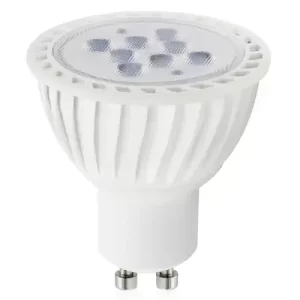
Small-size screw-type bulbs: E14 and E26
E14 and E26 are popular small screw-type LED bulbs (common LED bulb sizes). The E14 bulb is a 14-mm screw-on light bulb that can screw into the E14 interface. The E14 LED bulb has a comparatively low power of typically 1W to 5W. E14 bulbs work well in wall lamps, night lights, ornamental lights, and other settings that don’t require high-level brightness. The E26 LED bulb has a screw diameter of roughly 26 mm. The E26 LED bulb has a relatively high output of 5–20 watts. E26 bulbs are appropriate to provide medium-level brightness. These two kinds of LED bulbs are often used in residential and industrial lighting.
Large-size screw-type LED bulbs: E40
The screw diameter of E40 bulbs is about 40 mm. E40 bulbs can work with relatively high voltage and power. For example, most 1000W metal halide lamps use E40 bulbs. The power of E40 LED bulbs can be above 30W. Due to its large diameter and high power, it often work in factories, warehouses, and other places that require large-area lighting. Generally, the larger the screw size, the greater the power and volume of the LED bulb.
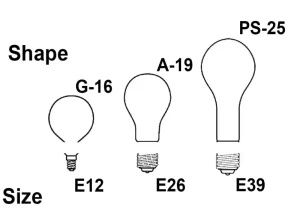
B22
B22 and E14 are named in the same way; both use the name of the lamp holder. B is the abbreviation of Bayonet, which means bayonet lamp holder, and the number behind it indicates the diameter of the lamp holder in millimeters. B22 is a type of bulb that matches a bayonet lamp holder with a diameter of 22 mm. The lamp holder has two protruding clips for snapping into the B22 lamp interface. B22 is generally a high-voltage lamp.
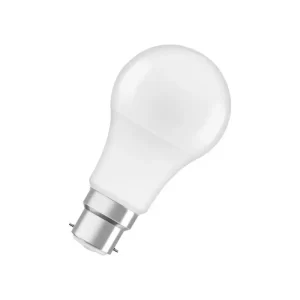
G24
G24 is a horizontal plug-in light bulb (common in fluorescent bulb sizes). Most of the downlights on the ceilings of some supermarkets and hotels are equipped with G24-style lamps. The bulb has a 180-degree illumination angle.
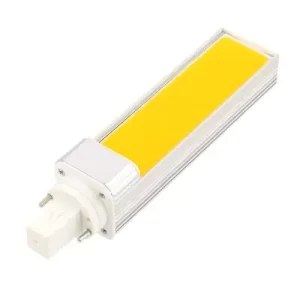
What size light bulb do I need?
- Common models: Common light sources for household lighting include incandescent lamps, LEDs, fluorescent lamps. The interfaces commonly used are screw E27 (standard bulb size), screw E14, bayonet B22, socket G5 G13, etc.
- For light source replacement: If you want to use a different light source to replace the original lamp, you should choose bulbs that can match the same interface, and calculate how many watts your new light bulbs should have. Read our blog What Are Lumens? to decide the power of your new lights.
- Shape selection: General lighting uses A-shaped bulbs. Table lamps use A- and C-shaped bulbs. Crystal lamps and other decorative lamps may use A-shape bulbs. Lamp troughs use T-tubes or soft light strips. On the premise of matching the type of bulbs and bases, you can choose bulbs of similar size but different shapes according to your preferences.
- Use the former bulb as a reference: A safer way is to take the old bulb to the store for comparison. This way you can compare the shape, size and connector of the bulb. If you want to buy online, you can refer to the specifications on the packaging or the information printed on the bottom of the lamp holder.
FAQ about light bulb sizes
E26 and E27, what is the difference?/E26 vs E27 difference?
E26 bulbs and bases are designed for 120 V systems, while E27 bulbs work with 240 V systems. They are similar types of bulbs and bases used in different countries.
Can I replace E26 with A19?
Yes. As we mentioned before, E26 and A19 bulbs are just named in different ways. As the matching base of A19 bulbs is also E26, they can replace the original E26 bulbs. For other types of the bulbs, you can consider replacing them with another type when they use the same base. The size of these two types of bulbs should be similar, and if you are changing into another light source, you should calculate the watts. For your safety, make sure to ask your manufacturer or electrician for advice.
While choosing light bulbs, what are other things I need to consider?
Yes. Three most important points you need to know are efficiency, lumen, and color temperature. Incandescent lamps, fluorescent lamps, LED lights, and other light sources have different efficiency. LED lights have the highest efficiency, which can be 90-120 lm/w, and it keeps improving. That’s why people are changing their lights into LED ones to save energy.
At the same power, LED lights can emit brighter light, which is measured in lumens. You shouldn’t simply consider the watt to find out how bright a lamp is, as the efficiency of lamps is different.
As for color temperature, it is about whether you want warmer or cooler white light. For decorative and relaxing lighting, choose lights with low color temperature. If you want to choose task lighting, the light should have a higher color temperature.
What size base is a standard light bulb?
In the United States, Canada, Japan and other places, the standard light bulb base size is E26. The standard light bulb model in Europe, China and Australia is generally E27.
Can I use e26 bulb in e27 socket?
Yea, but the E26 lighting fixture functionally operates at 120V in North American regions yet the E27 version functions under 220–240V throughout Europe and Asia. Bulbs with dual voltage settings for both 120V–240V can safely function. Otherwise, using a 120V-only bulb in a 240V socket may burn it out.
Conclusion
After reading this light bulb size guide, you must have known how light bulb sizes and types are named. You can find out what kind of base they use according to their name or refer to the common matching of bulbs and bases. We also introduce popular types of light bulbs and their applications. Then, we provide a guideline for you to choose a new light bulb. We hope this blog helps when you don’t know what type of bulbs you should choose. Come to Casyoo for more useful blogs!
